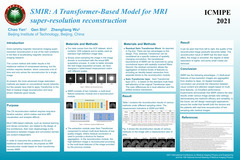报告详情
SMIR: A Transformer-Based Model for MRI super-resolution reconstruction
编号:91
访问权限:仅限参会人
更新:2021-10-30 22:03:44 浏览:1723次
张贴报告
摘要
Down-sampling magnetic resonance imaging super-resolution reconstruction is one of the main problems in the field of accelerating magnetic resonance imaging research. The current method with better results is the traditional method of compressed sensing, but the solution requires iteration, which consumes a lot of time and only solves the reconstruction for a single image. At present, the more advanced image restoration methods are based on convolutional neural networks, but few people have tried to apply Transformer to the field of medical image reconstruction and have shown relatively good results. In this article, we propose a magnetic resonance imaging reconstruction model SMIR based on Swin Transformers, namely SMIR. SMIR consists of two modules: a multi-level feature extraction module and a reconstruction module. The model combines frequency domain and spatial domain losses to better reconstruct image details. We compared this model with some traditional image processing methods and advanced convolutional neural networks image restoration methods. The experimental results show that our method achieves the best results.
关键词
Transformers,Magnetic resonance imaging (MRI),Deep learning,Super-resolution Reconstruction
报告人

超 严
无 北京理工大学稿件作者
全部评论
重要日期
-
会议日期
11月13日
2021
至11月14日
2021
-
09月30日 2021
报告提交截止日期
-
11月14日 2021
注册截止日期
主办单位
IEEE北京分会
中国生物医学工程学会医学物理分会
中国电子学会生命电子学分会
中国生物医学工程学会医学物理分会
中国电子学会生命电子学分会
承办单位
中国科学技术大学
安徽省生物医学工程学会
安徽省生物医学工程学会
联系方式
- Mrs. Yang
- ic******@ustc.edu.cn
- +86********
历届会议
-
2017年11月04日 中国 Beijing,China
2017 International Conference on Medical Imaging Physics and Engineering -
2017年11月03日 中国 海淀区
2017 IEEE 国际医学影像物理和工程大会 -
2013年10月19日 中国 沈阳市
2013 IEEE国际医学影像物理和工程大会暨第七届中国医学影像物理学术年会



发表评论